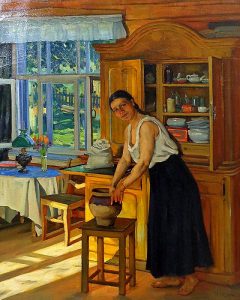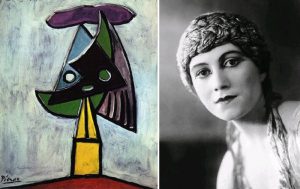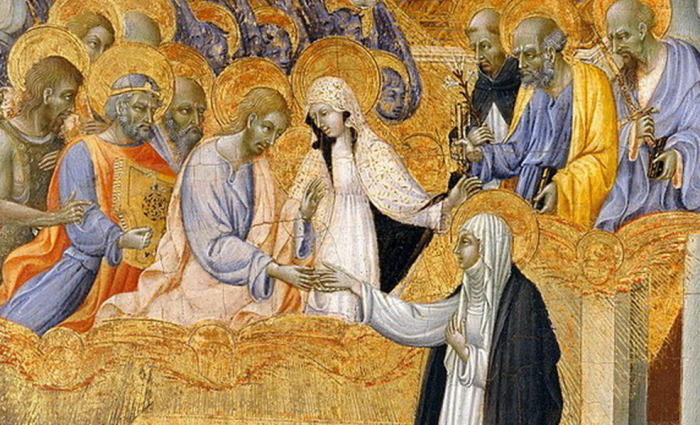very popular
Paintings of an artist who has loved one woman and one city for 60 years
 It is not often that fate favors artists with benefits at the same time in all areas of life. Few people manage to walk a life and career on a smooth road, without bumps and sharp turns. Konstantin Fedorovich Yuon is one of such minions of fate. He was lucky in his work, he was lucky in marriage … And what else does a creative person need? Today in the review is an amazing story of the artist’s tremulous love.
It is not often that fate favors artists with benefits at the same time in all areas of life. Few people manage to walk a life and career on a smooth road, without bumps and sharp turns. Konstantin Fedorovich Yuon is one of such minions of fate. He was lucky in his work, he was lucky in marriage … And what else does a creative person need? Today in the review is an amazing story of the artist’s tremulous love.
Konstantin Fedorovich Yuon (1875-1958) – Russian painter, landscape master, theater artist, art theorist, with the title of academician of the Academy of Arts of the USSR, national artist, Stalin Prize laureate. And if in a nutshell to characterize his artistic work, then Konstantin Yuon was an excellent master of urban landscapes and theatrical scenery. He painted portraits, portrayed Russian nature and monuments of ancient architecture, painted ancient provincial Russian cities and small villages. Well, of course, he devoted the lion’s share of his heritage to Moscow, where he was born, lived his whole life and loved immensely.
Yuon began his work with the golden shining domes of Russian churches, the place of which after the revolutionary events was taken by large-scale canvases depicting parades on Red Square. Continue reading
7 beloved women by Pablo Picasso
 “If he had not become an artist, he would have become Don Juan,” once said a friend of Pablo Picasso, the French playwright Jacques Cocteau. And it’s hard to disagree with him. You can write a lot about the views of the artist (creative, smoothly flowing into sharply political), family and friends (who have had a significant impact on his success), but this review will focus on the role of women in the work of Pablo Picasso.
“If he had not become an artist, he would have become Don Juan,” once said a friend of Pablo Picasso, the French playwright Jacques Cocteau. And it’s hard to disagree with him. You can write a lot about the views of the artist (creative, smoothly flowing into sharply political), family and friends (who have had a significant impact on his success), but this review will focus on the role of women in the work of Pablo Picasso.
In many ways, the stages of the artist’s work (blue, pink, cubic, etc.) were accompanied by the woman who was next to him during his life. To be more precise, it was the woman who led him to one or another stage of the creative path with the totality of her styles and directions. As Picasso himself admitted: “Life is extended by work and women.” Continue reading
How Peter Konchalovsky managed to avoid repression and why the artist was called the Soviet Cezanne
 Not many painters who disobeyed the socialist regime in times of bloody repression managed to escape punishment. Today I would like to recall the name of one of them – Pyotr Petrovich Konchalovsky. In those terrible years, the artist managed to remain a “pure” painter who avoided the embodiment of socialist reality and portraits of its leaders in his creations. Moreover, to take as a basis for his work the direction of the hostile Western art, which is why he was named in his time – the Soviet Cezanne.
Not many painters who disobeyed the socialist regime in times of bloody repression managed to escape punishment. Today I would like to recall the name of one of them – Pyotr Petrovich Konchalovsky. In those terrible years, the artist managed to remain a “pure” painter who avoided the embodiment of socialist reality and portraits of its leaders in his creations. Moreover, to take as a basis for his work the direction of the hostile Western art, which is why he was named in his time – the Soviet Cezanne.
It should be noted that the great merit of Anatoly Lunacharsky, the first People’s Commissar of Education of the RSFSR, was that Pyotr Petrovich was allowed to create freely, despite the attacks of critics who longed for the proletarian coup and the ecstasy of socialist work in the artist’s works. Anatoly Vasilievich convinced the guardians of the dogmas of socialist realism that Konchalovsky in his modern day “sings the poetry of our everyday life” and, apparently, the People’s Commissar did quite well. Continue reading




